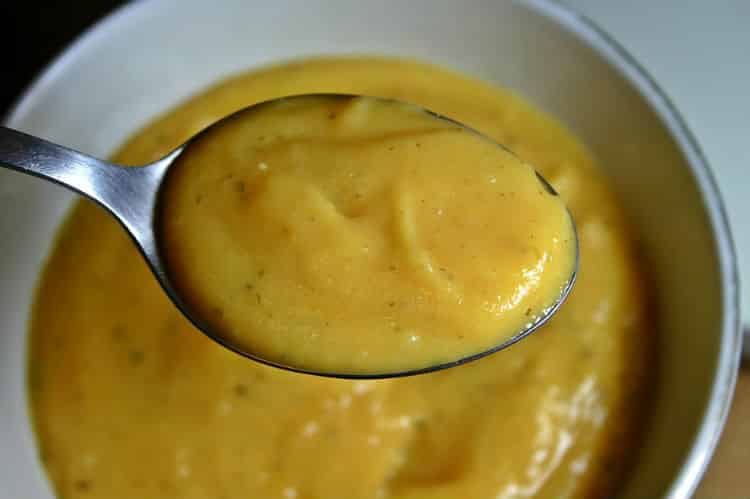To learn about the equipment you need to make purées, you can consult the previous entry Making Homemade Baby Purées.
Updated article : April 2024.
How to make baby purées.
Procedures and practical advice:
- Wash your hands, the work surface, your utensils and of course the fruits and vegetables you want to make your purées with;
- Remove the skin, the heart, the pits, seeds, the skin and bones from fish, the bone and visible fat from meat or poultry;
- Cut up the food;
- For fruits and vegetables, add a maximum of 1.5 cups at a time to the blender to get the smooth texture you want;
- For meats, use 1 cup a time because it is easier to get the desired texture;
- You can use breast milk, water used to cook food, or a homemade broth added in small doses to the food in the blender to obtain your desired texture. If you use commercial newborn milk formulas, you can also mix it with purées, but they can’t be frozen. The more powerful your blender, the less liquid you will need to get a smooth purée;
- Don’t freeze too many purées at a time to avoid waste and promoting variety while respecting freezing times for each food. Of course, if you have a surplus of purées, it’s possible to reuse them in family recipes like soups or muffins.
Fruit and vegetable purées:
Preparation:
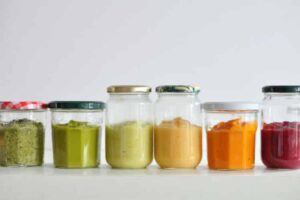 First, you can make certain non-cooked fruit purées like avocado, bananas, mango, watermelon, pineapple. Some of these fruits, such as strawberries and pineapple, contain a lot of water. When we purée them, many will be more liquid than solid, but that shouldn’t stop you from adding this liquid to your baby’s cereal to taste different. Have them drink it in a glass rather than as a purée too.
First, you can make certain non-cooked fruit purées like avocado, bananas, mango, watermelon, pineapple. Some of these fruits, such as strawberries and pineapple, contain a lot of water. When we purée them, many will be more liquid than solid, but that shouldn’t stop you from adding this liquid to your baby’s cereal to taste different. Have them drink it in a glass rather than as a purée too.
If your baby eats purees between the ages of 4 and 6 months, there’s no need to throw away the water used to cook carrots, turnips, beets and spinach. According to the latest update (2024) from INSPQ, there is no risk or disadvantage to consuming this water for babies aged 3 months and over, in relation to its nitrite content.
Cooking:
Ideally, make your fruit and vegetable purées quickly after purchasing the foods to keep them as fresh as possible.
- Steam cook the food in a steam cooker with a little water in the pot or a microwave-ready container. If the water is already boiling, this will allow the food to keep more vitamins, as quick cooking means less loss of nutrients.
- Use your blender and add 1.5 cups of fruit or vegetables at a time with a bit of cooking water, breast milk or homemade broth.
- A frozen purée will be more liquid after thawing. At the start, you will need to make it thicker rather than more liquid, as it will be difficult to feed it to the baby once thawed. Once again, if it happens, you can use fruit or vegetable purée in a small drinking glass or smoothies or thicken it with baby cereal.
Legume purées:
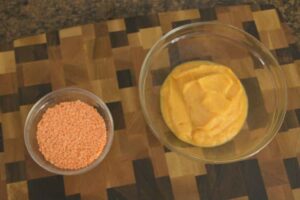 All legumes (lentils, chickpeas, red, white and black beans, soybeans) are meat substitutes. They’re less expensive and offer high nutritional value. They can be bought dry or canned, and others can also be purchased frozen.
All legumes (lentils, chickpeas, red, white and black beans, soybeans) are meat substitutes. They’re less expensive and offer high nutritional value. They can be bought dry or canned, and others can also be purchased frozen.
If you choose legumes in a can, it’s important to check that they haven’t added salt or other additives. As they’re already cooked, all you have to do is purée them.
Preparation:
If you used dried legumes, they often need to soak for 8–12 hours, usually overnight.
Use at least three times the water quantity for a portion of legumes for soaking, as they will increase in volume.
To promote taste, whether you used canned or boiled legumes, mix them with another purée of your choice, such as squash, yams or another vegetable. You can start with ¼ legumes with ¾ vegetables and gradually add water.
Smaller sized legumes, such as lentils, split yellow peas (not whole), mungo and azuki beans don’t need to soak and can be cooked directly in water. They’re very practical if you want to make small quantities of purée quickly and add nutritional value to other purées.
Cooking:
- First, rinse the legumes and use fresh water (not from soaking) to cook the legumes. You cook them in water, but you can also use a crockpot in a salt-free homemade broth. The longer the soaking time, the more the cooking time will be reduced.
- For small legumes that don’t need soaking, cook between 20 and 45 minutes in water. When they’re cooked, you can crush them with your finger..
- For legumes that need soaking, cook 1-3 hours.
Tofu purée
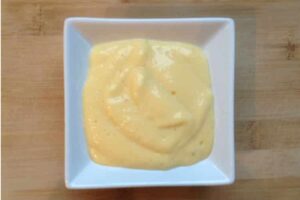 Tofu is a meat substitute and an excellent choice to introduce starting at six months. Silken tofu should be used for its smooth texture, and soft tofu is also a good choice. Firm tofu will provide a thicker texture. In all cases, it’s important to buy plain tofu without added sugar or flavours.
Tofu is a meat substitute and an excellent choice to introduce starting at six months. Silken tofu should be used for its smooth texture, and soft tofu is also a good choice. Firm tofu will provide a thicker texture. In all cases, it’s important to buy plain tofu without added sugar or flavours.
Preparation:
Tofu is easy to cook. You can give it to your baby as is or mix it with a fruit purée of your choice.
Silken tofu is very liquid. Consider this when you mix it with thawed fruits that have more water. Mango or banana are good choices which provide a thicker purée. You can serve it cold or warm based on your baby’s tastes.
Firm tofu can also be mixed with a vegetable or fruit, for example, ¼ tofu for ¾ fruit sauce. The texture will be thicker than with silken tofu. It’s interesting when you’re shifting towards thicker textures. You can put it in the blender if you want a chunkier texture.
Tofu has a neutral taste and is very versatile. You can mix it with many foods of your choice and offer it both as a meal or dessert.
Freezing:
You can freeze firm tofu. On the other hand, because it contains a lot of water, its texture can change after freezing. It’s sometimes necessary to remix it to give it a uniform texture. Silken tofu doesn’t freeze well, so we suggest that you serve it fresh.
Meat purée
For meats, use the freshest meat possible, or thawed meat. Buy lean meat and remove visible fat.
The best kinds of meats for purées are:
For poultry:
- Brown and thigh meat are much more tender after cooking;
- Chicken breasts are a good choice but are drier after cooking;
- Grain-fed turkey is also tender for thighs, but the rest remains drier.
For beef (including veal):
- Deboned flat-iron, inside round and sirloin are good choices for their tenderness when making purées;
- A chuck roast is challenging to make into a purée due to fibres and marbling. You can cut the meat into about 1-inch cubes for cooking.
For pork: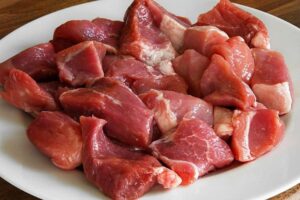
- Pork butt cubes are a good inexpensive choice and very tender in a stew.
- An inside round and pork filet are also good choices, but the latter is a bit drier after cooking.
For lamb:
The lamb often tastes stronger. You can try to start babies with other meats. For the purée, the tenderest part of the lamb is shoulder roast.
For fish:
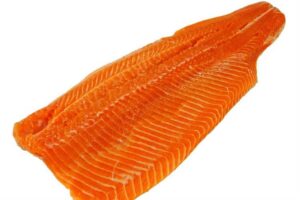 Don’t forget that certain fish contain heavy metals. Just like for pregnant women, we don’t advise giving these types of fish to babies. On the other hand, you can give them salmon, tilapia, haddock, trout and sole, for example.
Don’t forget that certain fish contain heavy metals. Just like for pregnant women, we don’t advise giving these types of fish to babies. On the other hand, you can give them salmon, tilapia, haddock, trout and sole, for example.
Please note that frozen fish usually contains little water. This is why it’s difficult to make a consistent purée after cooking.
Typically, you can get a good texture by cooking the fish without additives in the oven in an aluminium foil en papillote. Don’t forget to remove all the bones.
Preferably, you should use skinless fresh or frozen fish. Never give raw fish to a baby due to risks of bacterial infection. Don’t use canned fish as it often has salt and other additives.
Cooking meat and fish purées:
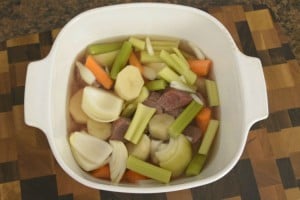
- Always cook meats and poultry using water both in the oven or stovetop to avoid drying the meat;
- When cooking, add chopped vegetables to the water which will add taste to meat purées (celery, carrots, potatoes, onions);
- Cooking meat in the oven with a water-based homemade broth takes about 2 hours at 325 degrees. At the end of the cooking, remove the vegetables and purée the meat using the cooking broth, which is tastier due to the vegetables. Cooking this way means the meat can be taken apart with a fork and is easier to blend in the blender. Then add liquid until you obtain your desired texture;
- Use only one cup of meat at a time in the blender and repeat based on the amount you want to purée;
- To get your baby eating meat or fish in a purée, which is often not as smooth as fruit, add their favourite fruit or vegetable—chicken and apple or pork and apple, for example. It’s really delicious and will surely help your baby increase their love for meat from the start, even if they’re eating a new texture.
To learn more about storing purées, please read the following entry: Storing Baby Purées.

